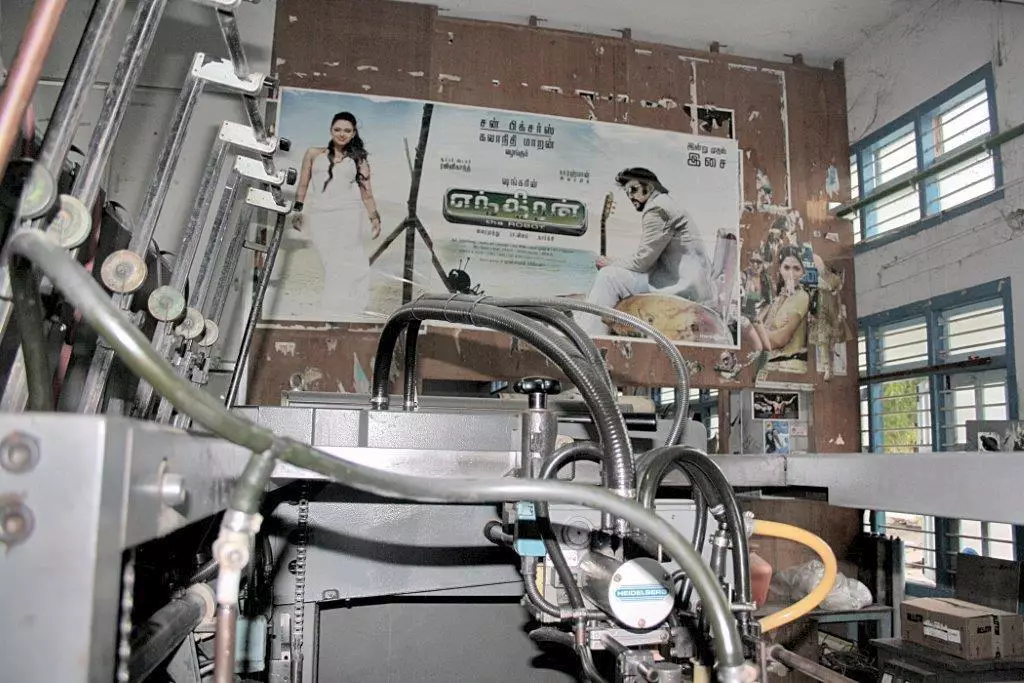Since 25 years, Safire has been anchoring film poster printing in India. This has been done through a technology blend for blockbusters as well as niche films.
A Dhanesekaran of Safire is back from a tour of Denmark, Sweden, Finland which culminated in Estonia. He loves to travel and prefers to go “off the beaten path”. His ring-tune is the famous theme from the Hollywood blockbuster, The Good, The Bad, The Ugly. He says his nephew has changed the tune on his cellphone in his absence.
Dhanasekaran sits at the helm of Safire Offset Printers in the heartland of Sivakasi. His press has been a pivot to the Indian film industry since the 1985, and has produced thousands of film posters in a year.
Dhanasekaran says, “Films posters are characterised by their vibrant and bright colours which highlight themes such as love triangles, scandal, family conflicts, revenge and redemption–and the heroes and heroines.”

Tiling of a movie poster with the plates
A film history through 10,000 film posters
The Safire stat file is staggering. The 600-staffed firm produces posters for 90% of Tamil films; 30% of Telegu / Kannada / Malayalam films. Besides this, Safire also produces film posters for Bhojpuri and Bengali films, as well as for international production houses like Columbia, Warner, Disney, for their English and dubbed films.
Safire has been rendering this service since 1985; which is a film poster history of 10,000 Indian films. A walk around the press could be a source of joy for anyone who collects authentic, original, genuine movie memorabilia. Dhanasekaran, who is a bit bemused by the suggestion that his press could double up as a cinema museum, says, “There are over 10,000 original vintage film posters; and at times multiple designs for each film.”
At times, these are real theatre-used advertising materials printed in limited quantities of 300 copies. All of them had been displayed when the film was released.
Dhanasekaran explains, “Besides printing, we handle the distribution to all the movie theatres in each and every centre, plus on-time delivery.”
He does a quick calculation for Tamil films, and says, “We have 240 MLAs in Tamil Nadu, which means there are a minimum of 240 film theatres. Natuarally, cities and main metros have a higher density of film theatres. Producers release three-four prints per centre. This has to be supplemented by film posters in the pre-release phase and then for the premiere show.”
He points out that today the cinema business is confined to a run of two-three weeks; as opposed to the “good old days of silver and golden jubilees.”

Film posters at Safire which includes Endhiran
He says honourable exceptions are movies like the Kamal Haasan starrer Vishwaroopam and the Rajinikanth starrer Endhiran with 75 lakh to one crore posters. Or the Telegu films, which “is twice the size of the Tamil film industry. Otherwise the print runs can be as low as 300 to 500 posters, to a maximum of 2,000 prints.

The Safire school bus service
Largest installation of UCTCP system in India
This is one the reason Safire has invested in seven Basyprint UV CTP setters. Dhanasekaran’s argument is, “One of the basic considerations to invest in UV CTP is the running cost and therefore ROI. Plus some of these posters don’t need more than 200lpi.”

tThe UV CTCP department
Dhanasekaran is quick to point out that Safire also consumes 2,500 thermal plates for their commercial and packaging work. But he adds, “When we did a survey of the market, we realised, the difference is 30% to 40% lower running cost against thermal. This can accrue significant savings for the small and medium-run film poster jobs.
Safire’s investment in Basyprint and Luscher CTP was much before UV CTP market opened up to smaller firms, who were unable to afford systems from the likes of Swiss-based Luscher and Netherlands-based Basysprint.
Dhanasekaran says, “The investment in these devices was [previously] only justified with a certain high volume plate usage, but now the plate volume is secondary to the investment, plus turnarounds have improved.” At times, Safire has to deliver films posters within hours and the platemaking process takes an hour.”
This feeds Safire’s battery of seven new sheetfed presses and eight pre-owned sheetfed presses.
Targetting packaging
Earlier, the cinema poster business was 100% of Safire’s turnover. Now it has declined to 50%. One reason is, the risky nature of the cinema business and the economics therein. And so, Safire is targetting commercial printing. For this, it is leveraging its all-India network in Mumbai, Delhi, Kolkata, Hyderabad and Chennai.
Other than FMCG products, Safire prints collaterals for the jewellery industry. Dhanasekaran says, “About 60% of India’s gem-based jewellery is diamond jewellery. Globally, India is the sixth largest consumer of diamond jewellery. During the last four or five years, several branded diamond jewellery players operated in India and now there are 40-50 brands.”

The Mitsubishi seven-colour interdeck press
Safire caters to this market. For this, Safire has invested in a brand-new CD 102 Heidelberg and a pre-owned seven-colour Mitsubishi with interdeck during the recession in UK. Movies and jewels: with the two Indian obsessions under its belt, Safire’s scope is growing.

The ink-blending unit

















 See All
See All